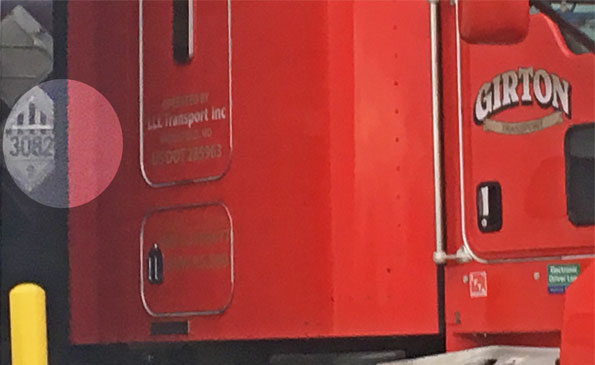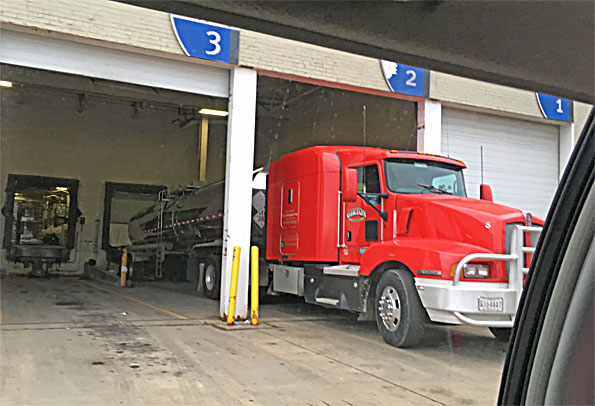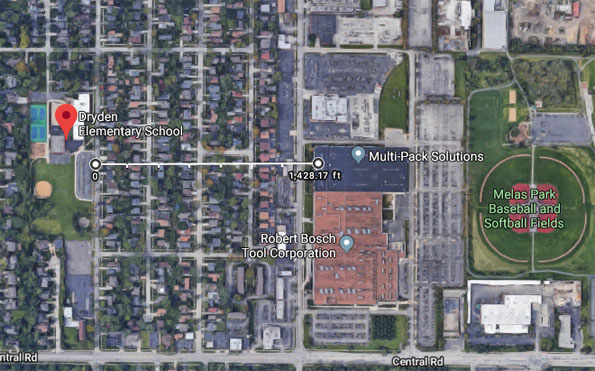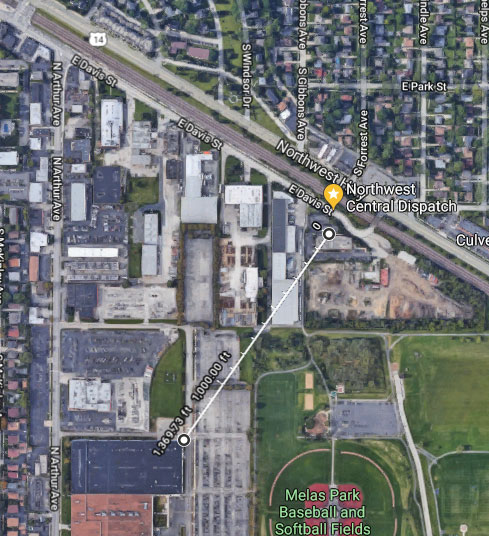MOUNT PROSPECT PLANT AT CENTRAL RD AND ARTHUR AVE LISTED AS PESTICIDE PRODUCER ON EPA FACILITY REGISTRY SERVICE (FRS) OVERVIEW
Depending on wind direction there is a noxious odor that emanates from a manufacturing plant at 1804 West Central Road. Some days the odor smells like Febreze, some days the odor smells like an apple scent deodorant, and some days like a chemical cleaner smell, according to residents that live near the plant. The building with the source of the odor is located on Arthur Avenue, just south of the ComEd yard, and just west of Melas Park.
When a chemical odor emanates from a commercial facility, people should be concerned whether the chemical is safe. What is the chemical? How concentrated is the chemical? Does the chemical cause symptoms? Is the chemical toxic? Does the chemical cause cancer?
Future Investigation Will Seek to Determine …
How Mount Prospect Officials Approved a Manufacturing Plant with an Offensive Odor caused by Chemical Releases in a Heavily Populated Residential Area?
Whether Irritants or Cancer-Causing Chemicals, Pesticides, Detergents, Deodorants are Emanating from a Mount Prospect Manufacturing Plant?
Whether Dryden School Students and Staff are exposed (less than 1500 feet from the Mount Prospect plant) to hazardous chemicals and irritants that could cause cancer, chronic pulmonary disease or asthma?
Whether Northwest Central Dispatch System 911 employees located nearby to the northeast are exposed to hazardous chemicals and irritants that could cause cancer, chronic pulmonary disease or asthma?
Whether ComEd employees next-door to the manufacturing plant property are exposed to hazardous chemicals and irritants that could cause cancer, chronic pulmonary disease or asthma?
Whether residential neighborhoods of tens of thousands of people are exposed to hazardous chemicals and irritants that could cause cancer, chronic pulmonary disease or asthma?
Whether the quality of life is decreased by chemical release and chemical odors from a Mount Prospect manufacturing plant, and whether the odors can decrease property values near the plant?
When lawyers that specialize in environmental chemical exposure go to work, one of the first tools they use is the cluster sample. Lawyers look for actual physical harm. The first step is to recognize whether there are a high number of cancer or respiratory complaints, or respiratory disorders and asthma/allergy reports in a geographical area. Once recognized, a more serious attempt at statistical analysis is applied to groups.
A Cancer Cluster is the occurrence of a greater than expected number of cancer cases among a group of people in a defined geographic area over a specific time period. A cancer cluster may be suspected when people report that several family members, friends, neighbors, or coworkers have been diagnosed with the same or related types of cancer.
An early warning sign could be cancer incidents involving children or young adults in a neighborhood or in a school.
Concerned individuals can contact their local or state health department to report a suspected cancer cluster or to find out if one is being investigated. Health departments provide the first response to questions about cancer clusters because they, together with state cancer registries, will have the most up-to-date data on cancer incidence in the area. If additional resources are needed to investigate a suspected cancer cluster, the state health department may request assistance from federal agencies, including the Centers for Disease Control and Prevention (CDC) and the Agency for Toxic Substances and Disease Registry (ATSDR), which is part of the CDC.
The CDC website provides links to state and local health departments. These agencies may also be listed in the blue pages of government listings in telephone books.
Although NCI does not lead investigations of individual cancer clusters, NCI researchers and staff may provide assistance to other investigative agencies as needed. In addition, scientists at NCI and researchers who are funded by NCI analyze variations in cancer trends, including the frequency, distribution, and patterns of cancer in groups of people. These analyses can detect patterns of cancer in specific populations. For example, NCI’s Cancer Mortality Maps website uses data on deaths from the National Center for Health Statistics, which is part of the CDC, and population estimates from the U.S. Census Bureau to provide dynamically generated maps that show geographic patterns of cancer death rates throughout the United States.
How are suspected cancer clusters investigated?
Health departments use established criteria to investigate reports of cancer clusters. The Centers for Disease Control and the Council of State and Territorial Epidemiologists have released updated guidelines for investigating suspected cancer clusters and responding to community concerns (See … Centers for Disease Control and Prevention. Investigating Suspected Cancer Clusters and Responding to Community Concerns: Guidelines from CDC and the Council of State and Territorial Epidemiologists. Morbidity and Mortality Weekly Report 2013;62(RR08):1-14. [PubMed Abstract]).
As a first step, the investigating agency gathers information from the person who reported the suspected cancer cluster. The investigators ask for details about the suspected cluster, such as the types of cancer and number of cases of each type, the age of the people with cancer, and the area and time period over which the cancers were diagnosed. They also ask about specific environmental hazards or concerns in the affected area.
If the review of the findings from this initial investigation suggests the need for further evaluation, investigators then compare information about cases in the suspected cluster with records in the state cancer registry and census data.
If the second step reveals a statistically significant excess of cancer cases, the third step is to determine whether an epidemiologic study can be carried out to investigate whether the cluster is associated with risk factors in the local environment. Sometimes, even if there is a clear excess of cancer cases, it is not feasible to carry out further study—for example, if the total number of cases is very small.
Finally, if an epidemiologic study is feasible, the fourth step is to determine whether the cluster of cancer cases is associated with a suspect contaminant in the environment. Even if a possible association with an environmental contaminant is found, however, further studies would be needed to confirm that the environmental contaminant did cause the cluster.
What are the challenges in investigating suspected cancer clusters?
Investigators face several challenges when determining whether a greater than expected number of cancer cases represents a cancer cluster.
Understanding the kind of cancers involved
To assess a suspected cancer cluster accurately, investigators must determine whether the type of cancer involved is a primary cancer (a cancer that is located in the original organ or tissue where the cancer started) or a cancer that has metastasized (spread) to another site in the body from the original tissue or organ where the cancer began (also called a secondary cancer). Investigators consider only the primary cancer when they investigate a suspected cancer cluster. A confirmed cancer cluster is more likely if it involves one type of cancer than if it involves multiple different cancer types. This is because most carcinogens in the environment cause only a specific cancer type rather than causing cancer in general.
Ascertaining the number of cancer cases in the suspected cluster
Many reported clusters include too few cancer cases for investigators to determine whether the number of cancer cases is statistically significantly greater than the expected number.
Determining statistical significance
To confirm the existence of a cluster, investigators must show that the number of cancer cases in the cluster is statistically significantly greater than the number of cancer cases expected given the age, sex, and racial distribution of the group of people who developed the disease. If the difference between the actual and expected number of cancer cases is statistically significant, the finding is unlikely to be the result of chance alone. However, it is important to keep in mind that even a statistically significant difference between actual and expected numbers of cases can arise by chance.
Determining the relevant population and geographic area
An important challenge in confirming a cancer cluster is accurately defining the group of people who should be considered potentially at risk of developing the specific cancer (typically the total number of people who live in a specific geographic area). When defining a cancer cluster, there can be a tendency to expand the geographic borders as additional cases of the suspected disease are discovered. However, if investigators define the borders of a cluster based on where they find cancer cases, they may alarm people about cancers that are not related to the suspected cluster. Instead, investigators first define the population and geographic area that is “at risk” and then identify cancer cases within those parameters.
Identifying a cause for a cluster
A confirmed cancer cluster—that is, a finding of a statistically significant excess of cancers—may not be the result of any single external cause or hazard (also called an exposure). A cancer cluster could be the result of chance, an error in the calculation of the expected number of cancer cases, differences in how cancer cases were classified, or a known cause of cancer, such as smoking. Even if a cluster is confirmed, it can be very difficult to identify the cause. People move in and out of a geographic area over time, which can make it difficult for investigators to identify hazards or potential carcinogens to which they may have been exposed and to obtain medical records to confirm the diagnosis of cancer. Also, it typically takes a long time for cancer to develop, and any relevant exposure may have occurred in the past or in a different geographic area from where the cancer was diagnosed.
Searching for evidence of a cluster and identifying or connecting the cause for a cluster can be very difficult.
When a noxious odor is detected in the air, it does not definitely mean that a harmful level of chemical is in the air, and that the chemical is capable of causing cancer. It depends on the specific chemical, the duration the chemical is in the air, and other factors. However, some detected odors could represent an immediate harmful level. At the very least, the harmful chemical could cause non-cancer problems, leaving an aftertaste or causing symptoms, such as headaches, sinus problems, sore throat, laryngitis, coughing, dizziness, eye irritation, swollen lymph nodes, malaise, mental vagueness, high blood pressure, joint aches, skin irritations or difficulty with breathing or simply ruin the normal enjoyment of fresh air outdoors. The odor could be offensive, but may not cause a verifiable health problem, such as a type of cancer.
In a worst case scenario the odor could represent a chemical exposure that is linked to cancer; birth defects; organ system toxicity; immune system toxicity; brain and nervous system toxicity; irritations of the eye, lung and skin; or allergy stimulants. People exposed to air pollution may not only be subject to cancers, but could also be subject to chronic pulmonary dysfunction and disability or chronic debilitating allergies and asthma.
The Multi-Pack Solutions manufacturing plant packs a variety of chemicals in pods. We currently don’t know exactly what those chemicals are.
A semi-trailer tanker truck parked in the loading dock at the north side of the building displayed a placard 3082, which represents an Environmentally Hazardous Substance, liquid “n.o.s.” or “not otherwise specified.” This can mean the tanker truck contains an unspecified hazardous waste, or it contains a chemical a company wishes to keep secret — as in a trade secret.
3082 Listing
cameochemicals.noaa.gov/unna/3082
N.O.S. – Not Otherwise Specified
UN 3082 Environmentally Hazardous Substances Placard (for sale)
 Diamond Placard 3082 “n.o.s” or “not otherwise specified” liquid hazardous material displayed on a tanker truck at a shipping dock on Friday January 26, 2018 at 3:40 p.m.
Diamond Placard 3082 “n.o.s” or “not otherwise specified” liquid hazardous material displayed on a tanker truck at a shipping dock on Friday January 26, 2018 at 3:40 p.m.
 Semi-trailer Tanker Truck with 3082 placard parked at shipping dock on Friday January 26, 2018 at 3:40 p.m.
Semi-trailer Tanker Truck with 3082 placard parked at shipping dock on Friday January 26, 2018 at 3:40 p.m.
The Multi-Pack Solutions manufacturing plant on Arthur Avenue in Mount Prospect describes itself as serving the unit-dose laundry detergent, dish detergent, agricultural pesticide and cleaning products industries. In other words the plant fills little packets with chemicals. During that process, chemicals and vapors are apparently leaking into the surrounding air and are carried by light winds to nearby neighborhoods. There are a significant amount of complaints coming from the area of the manufacturing plant.
Serving the unit-dose laundry detergent, dish detergent, agriculture, pesticide, and cleaning products industries, we fill both single- and multi-chamber water-soluble pouches with liquids and powders—and we create them around the clock—with absolute precision, supported by our on-site laboratory. Multi-Pack Solutions leads the water-soluble packaging industry in capacity, allowing us to handle projects large and small.
MultiPack Website
The question you might be asking is … How did a manufacturing plant that involves commercial detergents, deodorants and pesticides — that apparently leak into the air — get approved in a location that is surrounded by populations of tens of thousands of people that live in homes, and apartments and where children go to schools nearby?
 The distance from MultiPack Solutions to Dryden School is less than 1500 feet.
The distance from MultiPack Solutions to Dryden School is less than 1500 feet.
When winds are from the west, the chemicals drift over Melas Park and neighborhoods in Mount Prospect along Central Road. People driving westbound on Central Road have reported the recognition of a strong odor as soon as they cross Busse Road.
When winds are from the southwest, the chemicals drift over the Stonegate neighborhood, neighborhoods east of the Stonegate neighborhood, Prospect High School, and Northwest Central Dispatch 9-1-1 Center. Northwest Central Dispatch is less than 1800 feet from MultiPack solutions. Prospect High School is less than 4800 feet from MultiPack Solutions.
When winds are from the south, the chemicals drift over the Stonegate neighborhood. Windsor School is less than 5,000 feet from MultiPack.
When winds are from the southeast, the chemicals drift over Mariano’s and the Recreation Park neighborhood.
When winds are from the east, the chemicals drift over the Scarsdale neighborhood, Dryden School, and downtown Arlington Heights. Dryden School is less than 1500 feet from Multi-Pack Solutions.
When winds are from the northeast, the chemicals drift over south Scarsdale and the Scarsdale Estates neighborhood.
When winds are from the north, the chemicals drift over neighborhoods south of Central Road in Arlington Heights, including Central Park East Apartments and Dana Point Condos.
When winds are from the northwest, the chemicals drift over neighborhoods south of Central Road in Mount Prospect.
When winds are calm, the bad air hangs over the nearby 2-4 blocks or about a 1500 feet radius around the manufacturing plant.
Multi-Pack at 1804 West Central Road is listed as a “PESTICIDE PRODUCER” under the header of “Environmental Interest Type” as part of the EPA Facility Registry Service (FRS) Overview (EPA Registry Id: 110067074276).
Is there a cancer cluster brewing in your neighborhood?
See also …
National Cancer Institute Cancer Clusters
Agency for Toxic Substances and Disease Registry (ATSDR)
Centers for Disease Control and Prevention
1–800–232–4636 (1–800–CDC–INFO)
www.atsdr.cdc.gov
The CDC’s ATSDR conducts public health assessments of potentially hazardous waste sites, performs health consultations on specific hazardous substances, designs and conducts health surveillance programs, and provides education and training about hazardous substances. Information about public health assessments conducted by ATSDR can be found on its Public Health Assessments and Health Consultations page. Reports can be searched by state or U.S. territory. Contact information for ATSDR regional offices is available online.
National Center for Environmental Health (NCEH)
Centers for Disease Control and Prevention
1–800–232–4636 (1–800–CDC–INFO)
[email protected]
http://www.cdc.gov/nceh/clusters
The CDC’s NCEH works to promote healthy and safe environments and prevent harmful exposures. The NCEH website includes general information about cancer clusters, links to resources, and answers to frequently asked questions.
National Institute for Occupational Safety and Health (NIOSH)
Hazard Evaluation and Technical Assistance Branch
Health Hazard Evaluation (HHE) Program
Centers for Disease Control and Prevention
513–841–4382
[email protected]
http://www.cdc.gov/niosh/hhe
The HHE Program of CDC’s NIOSH investigates potentially hazardous working conditions, including suspected cancer clusters. Employees, authorized employee representatives, and employers can request these evaluations. HHE reports are available on the NIOSH website.
Office of Occupational Medicine
Occupational Safety and Health Administration (OSHA)
U.S. Department of Labor
202–693–2323
http://www.osha.gov/dts/oom/index.html
OSHA’s Office of Occupational Medicine performs workplace-related case evaluations and cluster investigations, including medical record reviews, employee interviews, and medical screening activities.
National Cancer Institute Causes and Prevention
facebook …
GET ALERTS on Facebook.com/ArlingtonCardinal
GET ALERTS on Facebook.com/CardinalEmergencies
GET ALERTS on Facebook.com/ArlingtonHeightsCrime
Stay informed with news from PublicSafetyReporter.com’s Emergencies Behind the Scenes Facebook page — Facebook.com/CardinalEmergencies. Includes links to favorite public safety and emergency rescuers and product manufacturers and safety companies that have Facebook pages. Submit your pictures or just stay up-to-date on with fire, rescue, EMS and police photo galleries. Please add your public safety photo to the timeline, or send a message to the page.
Help fund The Cardinal Arlingtoncardinal.com/sponsor
NWCDS 911 …

